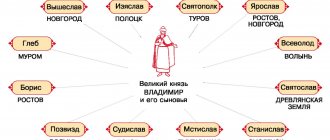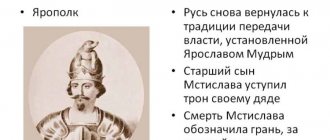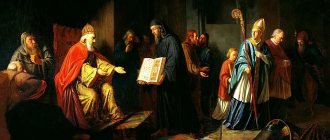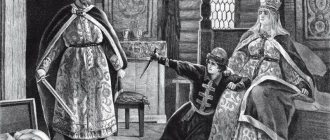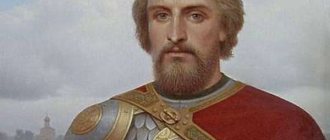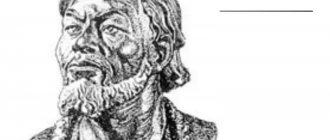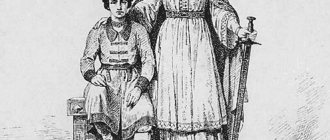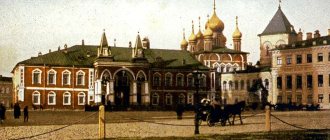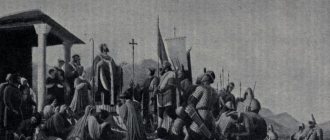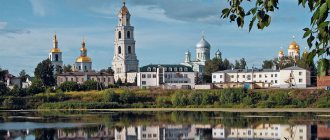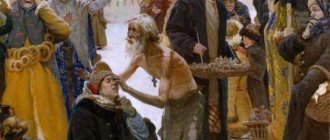A brief history of the reign of Prince Vladimir
Prince Vladimir the Holy
The future Prince Vladimir Svyatoslavich was born approximately in 962. The boy was the illegitimate son of the Kyiv prince Svyatoslav and the housekeeper of Princess Olga Malushi. And although, according to ancient pagan customs, the status of a child in society was determined by the paternal line and dynastic rights were thus not infringed, the offensive nickname “robichich,” that is, a slave son, weighed heavily on Vladimir for a long time.
Eight years later he becomes the Prince of Novgorod. Dobrynya, his uncle and governor, was appointed mentor in the reign of Novgorod over the young prince.
Origin of Prince Vladimir
Accession to the throne in 978
After the death of Grand Duke Svyatoslav in 972, Yaropolk began to rule Kievan Rus. Three years later, an internecine struggle begins between the sons of Svyatoslav, as a result of which first the Drevlyan prince and Vladimir’s brother Oleg, and then Yaropolk himself, perish. Thus, Vladimir’s ascension to the Kiev throne was overshadowed by fratricide. In 978 he became the sole ruler of Rus'.
During his reign, Vladimir repeatedly waged wars with his neighbors: he went against the Vyatichi, fought with the Poles, conquered the lands of the Yatvags and Radomichs, opening the way to the Baltic, and also managed to defeat the Volga Bulgarians and subjugate the Croats.
Being a zealous pagan, the prince continually erected new temples rich in decoration and erected idols, to which bloody human sacrifices were often made. However, with the growth of the Christian faith throughout Rus', including in the princely squad, Vladimir began to have doubts about the fidelity of the faith.
Establishment of the Christian religion in Rus'
Soon the prince decides to establish unity of faith in Kievan Rus, thereby uniting the population and showing the world the civilization of his state. Among several popular religions, Vladimir decided to choose Christianity. Historians note this choice as the most successful political princely reform. Indeed, in this way, Rus' became much closer to Byzantium, which brought considerable benefits and development to society.
After his baptism and adoption of the name Vasily in 987, the prince ordered the construction of churches and temples. Scientists believe that the process of Christianization of Kievan Rus itself took place quite peacefully, because at that time many were familiar with Christianity.
The internal policy of this ruler was distinguished by a creative, innovative character. Vladimir built stone cities, strengthened borders and was the first to mint silver and gold coins in Rus'.
Religious reform of 980
Domestic policy of Prince Vladimir
Domestic policy of Prince Vladimir
The prince died on July 15, 1015.
Monument to Prince Vladimir
Test your knowledge! Test on the topic: The reign of Prince Vladimir
Brief biography of Grand Duke Vladimir I Svyatoslavich (Saint | Baptist | Red Sun)
Vladimir I Svyatoslavich was the son of Svyatoslav the Brave and the slave-housekeeper Malusha. Born in the village of Budyatino around 960, Vladimir was soon taken away from Malusha and the prince was raised along with his half-brothers Oleg and Yaropolk under his grandmother, Princess Olga. In 969, Olga died and before returning to Bulgaria, Svyatoslav gave the cities to his sons to rule: Yaropolk got Kyiv, Vladimir got Novgorod, Oleg went to reign with the Drevlyans. This was the last meeting of Vladimir with his father - in the spring of 972, Svyatoslav was waylaid and killed by the Pechenegs on the Dnieper rapids.
Grand Duke Vladimir I Svyatoslavich Khud. W. Tuck
The first years of the brothers' reign proceeded peacefully, but in 977 the first civil strife in Rus' began - the Kiev governor Sveneld took advantage of his influence on Yaropolk and, in an effort to take revenge on Oleg for the death of his son, pushed the ruler of Kyiv to war with his brother.
Upon learning of Oleg’s death, Vladimir fled from Novgorod “overseas”, returning a few years later with a mercenary army of Varangians. After the humiliating refusal of the Polotsk princess from his proposed marriage, Vladimir took Polotsk by storm and made her his wife by force, then moved to Kyiv. Finding a traitor among the governor Yaropolk, the prince cunningly lured his brother out of the besieged fortress and ordered his death, after which he began to rule in Kyiv.
In 980, Vladimir tried to carry out the so-called. “pagan” reform - to create a common pantheon on the basis of the Slavic gods, which should unite the disparate tribes around Kyiv, however, after a series of uprisings of the Vyatichi and Radimichi, it became obvious that the idea had failed.
In foreign policy, Vladimir was active - he organized campaigns against the Khazars and Volga Bulgars, captured the Cherven cities from the Poles, and also subjugated the tribes of the Yatvingians and White Croats adjacent to Poland. At the same time, Vladimir continued to look for opportunities to increase his own power - in 986, preachers from various Abrahamic religions (Muslim, Judaism, Latin and Greek churches) came to him, the prince listened to everyone, but did not fully decide on his choice.
In 988, the prince launched a campaign against the Greek colony in Crimea - Korsun. After several months of siege, the city was taken and, under the threat of a campaign against Constantinople, Vladimir forced the Byzantine emperors to marry Princess Anna to him. The prince had to fulfill the conditions put forward by the Greeks - to be baptized himself and spread Christianity in Rus', as well as to help with troops to suppress the uprising in Byzantium and in the Bulgarian-Byzantine war. Returning to Kyiv, Vladimir ordered the destruction of the statues of Slavic gods, and the next day he baptized the people of Kiev. The Novgorodians did not appreciate the prospects of abandoning the faith of their ancestors, but were forced to obey the governor Dobrynya sent by order of Vladimir - having met resistance, he ordered the city to be set on fire and, taking advantage of the turmoil, occupied it with troops.
After this, the prince faced an ever-increasing onslaught of the Pechenegs and organized the construction of border fortified cities to warn of raids and protect the inhabitants. At the same time, clashes with the Polish prince Mieszko I continued, which, after another victory for Vladimir, ended with the signing of peace. Mieszko's son, Boleslav I, tried to recapture the Cherven cities in an alliance with the Pechenegs, but failed and made peace with Vladimir, strengthening it with a dynastic marriage between his daughter and the son of the Kyiv prince Svyatopolk.
At the end of his life, Vladimir decided to change the order of succession to the throne, planning to transfer control of Kiev to his youngest and favorite son, Boris, instead of his eldest sons. Perhaps this was the reason for the uprising of other heirs: in 1014, Yaroslav the Wise stopped paying his father the tribute due from Novgorod, and Vladimir, on charges of preparing a coup, ordered his son Svyatopolk to be thrown into prison along with his Polish wife and her bishop. The aging prince was planning to go to war against Yaroslav, but he fell ill and died on July 15, 1015. Immediately after his death, Svyatopolk seized power in Kyiv, and the second civil strife in Rus' began between him and Vladimir’s other heirs.
This is a short version of the biography of Vladimir I Svyatoslavich. If you are interested in studying the life of the Grand Duke in more detail, we have prepared a full version of the history of his activities, illustrated with a large number of portraits and thematic images (reading time 30-50 minutes):
Detailed biography
Section "Vladimir I"
Test on the topic: “The reign of Prince Vladimir”
Time limit: 0
Navigation (job numbers only)
0 of 4 tasks completed
Questions:
- 1
- 2
- 3
- 4
Information
Test on the topic: “The reign of Prince Vladimir”
You have already taken the test before. You can't start it again.
The test is loading...
You must log in or register in order to begin the test.
You must complete the following tests to start this one:
results
Correct answers: 0 out of 4
Your time:
Time is over
You scored 0 out of 0 points (0)
Categories
- No category 0%
- If you have: 4 points - excellent knowledge of the topic If you have: 3 points - good knowledge of the topic If you have: 2 points - satisfactory knowledge of the topic If you have: less than 2 points - poor knowledge of the topic
- 1
- 2
- 3
- 4
- With answer
- With a viewing mark
- Task 1 of 4
1.
Indicate the year of birth of Prince Vladimir:
Right
Wrong
- Task 2 of 4
2.
Indicate the year of Prince Vladimir’s accession to the Kiev throne:
Right
Wrong
- Task 3 of 4
3.
Name the year of the baptism of Rus':
Right
Wrong
- Task 4 of 4
Prince Vladimir in Rus' was called the Red Sun, this shows how ordinary residents loved and appreciated him. The prince, who was able to unite the country and prevented it from falling apart, was born more than a thousand years ago, his father was Svyatoslav, and his mother was a simple housekeeper.
The Grand Duke was taken from his mother at the age of three and raised as a future warrior. When Vladimir and his brothers Oleg and Yaropolk grew up, their father gave each of them a city to rule. At that time, the capital of our country was the city of Kyiv, it went to Yaropolk. Oleg ruled the Drevlyans, now Belarus is in this place, Vladimir got Novgorod. When his father died, Vladimir's brothers started a war, each wanted to rule the country himself. Yaropolk killed Oleg and decided to conquer Novgorod. Vladimir, with the help of his Varangian friends, gathered an army and was able to recapture his lands. Yaropolk was an unjust ruler, local residents willingly supported Vladimir. After the prince conquered the capital, he began to rule independently.
Now his task was to get rid of the Varangian assistants. They had a bad habit of banditry on Russian lands, and Vladimir promised to defend his native land. He went for help to another state; the most powerful neighbor at that time was Byzantium. The Byzantine emperor agreed to take the Varangians into his service, and Vladimir decided to make ties with his useful neighbor even stronger.
At that time, the Slavs believed in their own gods, the main one of which was Perun. For the sake of profitable connections with his neighbors, Vladimir betrayed his native religion and destroyed all the places where people were accustomed to pray. He knew that the Orthodox religion, like in Byzantium, would bring the countries closer together and make the Russian people more manageable. The new religion will turn them into more dependent people, teaching them to obey rulers and priests.
Because Vladimir forced the Slavs to accept baptism, the Byzantine emperor gave him his sister Anna as his wife. After the princess married Vladimir, the two of them began to change the faith of people in Russia, building many churches, monasteries and schools for priests.
His decision turned out to be successful; Russia still exists as a separate country. Under the rule of Vladimir, the inhabitants prospered, wars stopped, cities were built and the first coins were minted. On the surviving samples you can see a portrait of Vladimir. The church decided to consider Vladimir a saint; his memory day is celebrated in July, the 15th. The largest monument can be seen in the capital Moscow.
For younger schoolchildren about the first Russian princes
About the first Russian princes for primary school students
Author: Alla Alekseevna Kondratyeva, primary school teacher of the Zolotukhin Secondary School, Zolotukhino village, Kursk region Description of the material: I offer you literary material - a reference book about the first Russian princes. The material can be used in a wide variety of forms: conversation, class hour, quiz, game hour, extracurricular event, virtual trip, etc. The material is designed to help any student answer such important questions as: 1) How did the Slavs live in ancient times? 2) When was the first Russian state formed? 3) Who controlled it? 4) What did the first princes do to strengthen the state and increase its wealth? 5) In what year did the Baptism of Rus' take place? Tsed: creation of a short, colorful, interesting reference book about the first Russian princes. Objectives: 1. Contribute to the formation of ideas about the role of the first Russian princes in the domestic and foreign policy of Ancient Russia. 2. To arouse students’ interest in the history of Russia, literature, expand their understanding of the history of Russia, develop a cognitive interest in reading, and instill a strong interest in books. 3. To form general cultural literary competence through the perception of literature as an integral part of national culture, to form the communicative competence of students. Equipment: Exhibition of children's books on the history of Russia: 1. Bunakov N. Living Word. S-P., 1863. 2.Vakhterovs V. and E. The world in stories for children. M., 1993. 3. Golovin N. My first Russian story in stories for children. M., 1923. 4. Ishimova A. History of Russia in stories for children. M., 1990. 5. Petrushevsky. Stories about old times in Rus'. Kursk, 1996. 6.What is it? Who is this? M., 1990. 7. Chutko N.Ya., Rodionova L.E. Your Russia: Textbook-reader for the beginning of school Obninsk. 2000. 8. Tenilin S.A. Romanov Dynasty. Brief historical reference book, N. Novgorod, 1990. 9. Encyclopedia. I explore the world. Russian history. Astrel, 2000. 10..Encyclopedia for children. History of Russia. M., 1995. Progress of the event: Teacher's story. It is known that the main written source about the distant times of our homeland are chronicles, including the famous “Tale of Bygone Years,” compiled in the 12th century by the monk of the Kiev-Pechersk Monastery Nestor. Today we will take another virtual trip to Ancient Rus' and find out how they lived and who ruled our people in ancient times. We will collect with you basic information about the life of the first Russian princes and compile our own written source for all inquisitive schoolchildren, which we will call “A Brief Historical Guide to the First Russian Princes.” More than a thousand years have passed since Rus' received Holy Baptism. This happened under Prince Vladimir, who was popularly nicknamed the Red Sun, the Baptist of Rus' in 988.
Today we celebrate the 1000th anniversary of the repose of the holy Equal-to-the-Apostles Prince Vladimir.
Prince Vladimir is the beloved grandson of Princess Olga, who did a lot to spread the faith of Christ in Rus'.
Our distant past - Russians, Russians, Russians - is connected with the tribes of the ancient Slavs. The Slavic tribes (Krivichi, Northerners, Vyatichi, Radimichi, Polyans, Drevlyans...) were constantly afraid that enemies would attack them, destroy settlements, and take away everything that had been accumulated by the labor of people. Fear forced the Slavs to unite to defend their lands together. At the head of such an association was an elder, a leader (they called him a prince). But the princes could not live together in peace: they did not want to share wealth and power. These discords continued for a long time. And then the Slavic people decided
:
“Let’s look for a prince who would bring order to our land, who would be fair and smart.” This is what the chronicle says. The Slavs turned to the Varangians for help (the Varangians lived in the northern country of Scandinavia). The Varangians were famous for their intelligence, patience and military valor. In 862, the first Rulers in the Ancient Fatherland were the brothers Rurik, Sineus and Truvor.
The first Russian prince Rurik led his army (squad) to Novgorod and began to reign there.
The country in which they settled began to be called Rus'. From that time on, Russia began to be called the lands on which Rurik ruled and after him other Varangian princes: Oleg, Igor, Olga, Svyatoslav. The princes strengthened Rus', maintained order within the country, and took care of its security.
Rurik (d. 879) - Varangian, Novgorod prince and ancestor of the princely, which later became the royal, Rurik dynasty.
In one of the campaigns to foreign lands, Rurik died. Instead, his relative, Prince Oleg, began to reign.
Oleg the Prophet (882–912)
“Let this city be the mother of Russian cities!”
- this is what Prince Oleg said about Kyiv-grad. Oleg really liked the city of Kyiv and he remained to reign there (as the chronicle tells, in 911, at the very beginning of the 10th century).
The city was surrounded by a moat and strong log walls.
Under Oleg, Kyiv not only grew richer, but also greatly strengthened. The prince strengthened his power with the help of military campaigns, which brought great wealth. Oleg received the nickname “prophetic” among the people, that is, omniscient, knowing what others are not given to know. This nickname reflects his insight and wisdom. There is a legend about the death of Prince Oleg. They say that a sorcerer (fortune teller) told him that he would die from his beloved horse. Since then, Oleg has not mounted this horse.
Once, many years later, the prince remembered his favorite, but found out that he was dead. Oleg laughed at the magician’s prediction and decided to look at the horse’s bones. The prince stepped on the horse’s skull and laughed: “Isn’t it possible for me to die from this bone?” Suddenly a snake crawled out of the skull and bit Oleg. He died from this bite.
Reproduction of the painting by V.M. Vasnetsov “Oleg’s Farewell to the Horse” Vasnetsov wrote these paintings for the work of A.S. Pushkin's "Song of the Prophetic Oleg"
(Demonstration of the book. An excerpt is read.) Student: The prince quietly stepped on the horse’s skull And said: “Sleep, lonely friend! Your old master outlived you: At the funeral feast, which is already not far away, It’s not you who will stain the feather grass under the ax And water my ashes with hot blood! So this is where my destruction was hidden! The bone threatened me with death!” From the dead head the grave serpent, Hissing, meanwhile crawled out; Like a black ribbon, it wrapped itself around the legs: And the stung prince suddenly cried out. Oleg was a brave prince, the people loved him and pitied him when he died. Oleg was not only brave, but also smart, he defeated many neighboring peoples, and ruled the state for 33 years.
Igor is the son of Rurik. (912-945)
Igor took power over Russia after Oleg's death. When Rurik died, Igor was a very small child and could not govern the people himself. His uncle, Oleg, reigned for him, who loved his nephew very much and took care of him. Igor's reign was marked by several major military campaigns of Russian troops. In addition to Byzantium, the Russians were attracted by the shores of the Caspian Sea, which attracted with their riches, because along the Volga across the sea there was a famous trade route (“from the Varangians to the Greeks”), which connected Rus' with the countries of the Arab East. Prince Igor was distinguished by his greed. He collected tribute from the Slavic tribe of the Drevlyans, who lived in dense forests. Igor’s warriors took away their honey, leather, furs, dried meat and fish. But everything was not enough for the prince. Then the Drevlyans decided to kill Igor in order to free themselves from the unbearable tribute and punish the prince for greed. And so they did.
Olga the Holy (945 - ca. 965) - Grand Duchess, widow of Prince Igor.
Princess Olga is one of the most interesting persons of ancient Russian history.
The uniqueness of her position lies in the fact that of all the rulers of the “Rurikovich empire” she is the only woman. Its origin is unknown. She was probably “from the family of neither a prince nor a nobleman, but from ordinary people.” During her reign, Rus' did not fight with any of the neighboring states. Saint Olga, Equal to the Apostles, became the spiritual mother of the Russian people, through her their enlightenment with the light of the Christian faith began. 957 – baptism of Princess Olga in Constantinople in the Church of Hagia Sophia. The high moral ideals of Christianity, the main commandments of God - “love the Lord your God with all your heart and with all your soul and your neighbor as yourself” - became close to the heart of Princess Olga. Olga became famous in Russia for her deeds of piety and built one of the first Russian Christian churches - the wooden Church of Hagia Sophia in Kiev.
The chronicle calls Olga “the wisest of all people” and talks about the princess’s tireless efforts to “organize the earth.” The baptism of all Rus' took place only under Olga’s grandson, Prince Vladimir. Olga lived for a very long time and left the kindest memory of herself.
Prince Svyatoslav Igorevich (957 – 972)
From an early age Svyatoslav was distinguished by his will, nobility and courage. He constantly practiced horse riding, learned to wield a spear, shot a bow, and grew into a mighty hero. Svyatoslav dressed not like a prince, in expensive clothes, but like a simple warrior. Svyatoslav was the living embodiment of a mighty force. The warrior prince lived only 27 years, but he managed to make six victorious campaigns and remained young and brave in the memory of the Russians. On campaigns he did not carry carts or boilers with him, did not cook meat, but, cutting horse meat, or “animal” (game), or beef into thin slices, fried it over coals and ate it. He did not have tents either, but slept on the ground. Gloomy and ferocious, he disdained any comfort, slept in the open air and put a saddle under his head instead of a pillow. When going on a campaign, he first sent messengers to say: “I’m coming to you.”
Grand Duke Vladimir is the grandson of St.
Olga, son of Svyatoslav. Student: The choice of faith is a ray in the window, Like the turning of the sun. In the simplicity of their hearts, the people called Vladimir the Sun. The grace of the Lord has descended. The light of Christ shone. The light of faith burns today, Becoming the foundation of the foundations. Princess Olga, often talking with her grandson, talked about her journey to Constantinople, about foreign, unknown lands, about peoples. And more and more about our God - Christ and His Mother, the Virgin Mary. Naturally wise, enterprising, brave and warlike, he ascended the throne in 980. Being a pagan, Vladimir was power-hungry and a zealous adherent of idolatry. Pagan gods of the Slavs
The pagan Slavs erected idols, around which they not only made sacrifices, but took oaths and held ritual feasts.
Nestor the Chronicler lists the names of the pagan idols that Prince Vladimir, while still a pagan, placed on the hill behind the Grand Duke's mansion: “a wooden Perun with a silver head and a golden mustache, Khors, Dazhbog, Stribog, Simargl and Mokosh.
And they made sacrifices to them, calling them gods, and brought their sons and daughters to them.” The most ancient supreme male deity among the Slavs was Rod. Already in Christian teachings against paganism in the 12th-13th centuries. they write about Rod as a god who was worshiped by all peoples. Rod was the god of the sky, thunderstorms, and fertility. They said about him that he rides on a cloud, throws rain on the ground, and from this children are born. He was the ruler of the earth and all living things, and was a pagan creator god.
This was how Russia was on the eve of Epiphany... In his young years, Prince Vladimir knew that he could unite people, make one big nation into a great power. This is a single faith, the faith by which the soul lives. That faith that is not bought or sold, but for which you are not sorry to give your life. Who and how suggested that Prince Vladimir choose a faith? The Volga Bulgars - the Mohammedan faith, the Germans - Catholicism, the Khazars - the Jewish faith, the Byzantines - the Christian faith. Prince Vladimir learned the Christian faith from a Greek philosopher. In 988 he was baptized in the city of Korsun and was named Vasily. Before this event, the prince was struck by blindness, from which he suddenly received healing during the sacrament of baptism performed on him. Returning to Kyiv, the Grand Duke baptized, first of all, his children on the Pochaina River, which flows into the Dnieper. The place where they were baptized is still called Khreshchatyk. Then, having destroyed idols in the city, he converted the people of Kiev to the Orthodox faith and thereby laid the foundation for the spread of the Christian faith in Rus'.
Baptism of Russia 1 student: Noon, heated by the heat, The earth is bursting with heat. Waves of warm light flood the fields. Above the green expanse, Where the river winds, Like snowy mountains, Clouds float into the distance. I stand over a cliff, I see a golden reach, the wind lazily ruffles strands of white birch trees. The current is silver, The streams are like from glass, Here Our Rus' received Holy Baptism. White birds are circling high above the Dnieper, and the words of the chronicler suddenly came to my mind. 2nd student: Nestor accurately and vividly described the Holy Day: Everyone hurried to the cliff, Old and small walked towards the Dnieper. Nature rejoiced, The distance was transparently bright! And countless people gathered on the Dnieper. The sun was just rising, the sky was turning pink. With images, with a censer, a procession of the cross went to the river. The vestments sparkled brightly, The crosses were decorated with pearls, stones, enamels of unearthly beauty. The priests walked singing and carried the holy cross, and with prayer they immersed the golden cross in the water. 3rd student: Above the Dnieper steep, the mighty Prince Vladimir watched the baptism in expensive vestments.
The people of Kiev walked into the water and entered up to their chests. And from now on the New Slavs chose the path. Angels sang from the sky, The river turned silver, The one that became a font For Rus' for centuries. A golden window opened in the sky: Many souls were saved in the prayer service of grace! Prince Vladimir ordered to baptize people everywhere and build wooden churches, placing them in the very places where idols had previously stood. Beautiful works of Greek architecture appeared in Russia. Temples were decorated with paintings, silver, and gold. And from that time on, the faith of Christ began to spread throughout the Russian land and penetrate into its most remote outskirts.
Saint Vladimir took care of his people, opened and improved schools, hospitals and almshouses. The poor, poor and weak found fatherly protection and patronage in him.
This is how Prince Vladimir lived until his death and died in his beloved village of Berestov, near Kiev, on
July 15, 1015.
The Russian Church appreciated the great feat of Prince Vladimir and canonized him, calling him Equal to the Apostles.
His memory is honored by the Church on the day of his death. This year 2015 we commemorate the 1000th anniversary of the repose of the Great Saint.
Test yourself: “The first Russian princes”
1. Establish the chronological sequence of the reign of the first Russian princes (Rurik, Oleg. Igor, Olga, Svyatoslav, Vladimir...) 2. Name the prince who proclaimed Kiev the capital of the ancient Russian state. (Oleg. In 882, Prince Oleg captured Kiev and made it the capital of the state.) 3. Indicate the name of the prince who always warned his enemy about the attack with the phrase “I’m coming to you” (Prince Svyatoslav is the son of Igor and Olga) 4. Ancient Slavs they worshiped the elements, believed in the kinship of people with various animals, and made sacrifices to deities. This faith got its name from the word “people”. What was the name of this belief? (Paganism. “People” is one of the meanings of the ancient Slavic word “language.”) 5. Because he did such a great and holy deed - he baptized his people into the true faith - after death he became holy and pleasing to God. Now they call him that - the holy prince. Which prince baptized Rus'? (Holy Prince Vladimir is the grandson of Princess Olga). 6. On what river did the Baptism of Rus' take place? (On the Pochaina River, which flows into the Dnieper) 7. Where did Grand Duchess Olga receive her Baptism of Christ? (In Constantinople, in 957) 8. In what century was the 1000th anniversary of the Baptism of Russia celebrated? (In the 20th, or more precisely in 1998.) Teacher: What do you think, children, what does the image of the holy Prince Vladimir of the once united Russia call the peoples to?
To unite again under the protection of the Orthodox Church, calls to build and strengthen Holy Rus'.
Our age will pass. The archives will open, And everything that has been hidden until now, All the secret stories of twists will Show the world glory and shame. Then the faces of other gods will darken, And every misfortune will be exposed, But what was truly great will remain great forever. N. Tikhonov
We recommend watching:
Class hour in elementary school on the topic: Children's rights Class hour in elementary school on the topic: Friendship Conversation with elementary school students on the topic: Signs Class hour in elementary school on the topic: Theater
Similar articles:
Class hour in elementary school. What is conscience and why does a person need it?
Class hour at the elementary school “Feathered Friends”
Class hour in elementary school “Norms of moral behavior”
Class hour for grades 1-4. Heroic glory
Extracurricular event “Birch - a symbol of Russia”, grades 1-4
Fratricidal war for the Kyiv table
From 972 to 980 Yaropolk ruled in Kyiv. All Russian lands were under his “hand”. Seeing that Rus' was tired of bloody campaigns, Yaropolk pursued politics like Olga. He secretly received baptism (perhaps under the influence of his first Greek wife), but this did not improve relations with Byzantium, and Yaropolk sought support in Christian Europe - in Rome and Germany .
Yaropolk's main task was to strengthen his power and subjugate the Drevlyans and Novgorodians. The chronicler Nestor says that one day Lyut , the son of the elderly governor Sveneld , encountered the Drevlyan prince Oleg while hunting, and he killed Lyut because he dared to hunt in his domain. Sveneld harbored a grudge against Oleg and began to persuade Yaropolk to go against his brother and seize his lands. Heeding Sveneld’s advice, Yaropolk set off for the Drevlyan lands. Oleg and his army came out to meet him. Yaropolk won the battle. Oleg and the remnants of his army wanted to take refuge in the city of Ovruch . But, crossing the bridge over the deep ditch surrounding Ovruch, Oleg fell into the ditch and was killed. Yaropolk learned about his brother’s death only the next day, when he heard about his death from an eyewitness. Having found Oleg's body, he mourned him, blaming Sveneld for his brother's death.
Meanwhile, the news of Oleg's death at the hands of Yaropolk reached Vladimir in Novgorod. Frightened Vladimir fled to the Varangians. Yaropolk subjugated Novgorod and became the sole ruler of Rus'.
In 980, Vladimir and the Varangian squad attacked Novgorod and challenged Yaropolk to battle. Preparing for the campaign against Kiev, he decided to conquer Polotsk , where Rogvolod , whose daughter, the beautiful Rogneda , was Yaropolk's bride. Vladimir killed Rogvolod and his sons and forcibly took Rogneda as his wife, who arrogantly called him the son of a slave.
Approaching Kyiv, where Yaropolk reigned, Vladimir besieged the city. Yaropolk fled south to the town of Rodnya , at the confluence of the Ros River and the Dnieper. Vladimir besieged Rodnya, and a terrible famine began there. Voivode Blud , who took the place of Sveneld, who died of old age, betrayed Yaropolk to Vladimir. At the meeting at which Yaropolk wanted to ask his brother for peace on any terms, the Varangians stabbed Yaropolk to death.
So the pagans of the north again struck at the Christians, led by Yaropolk, who had gathered in the south of the country. Christians tried to introduce Kievan Rus into a number of civilized countries in Europe and Asia, and the old pagan nobility, relying on the same pagan Scandinavia, did not want changes in the policy of “war and trade.”
Having defeated his brother, Vladimir had to reckon with the pagans who helped him capture Kyiv. Having become a prince, he exhibited new idols of pagan gods in Kiev, led by Perun . But “The Tale of Bygone Years” is silent Veles Perhaps the absence of Veles meant that Vladimir still needed change.
Russian history
Vladimir was born around 962, he was the illegitimate son of the Grand Duke of Kyiv Svyatoslav Igorevich and Malusha, the housekeeper of Grand Duchess Olga. Although, according to pagan customs, social status was determined by the father, and dynastic rights were not infringed, the nickname “robicic” (son of a slave) haunted him for a long time.
In 970, Vladimir became the Prince of Novgorod, and his uncle, Voivode Dobrynya, was appointed his mentor during his childhood.
After the death of the great Kyiv prince Svyatoslav in 972, Yaropolk began to rule Kiev, and 3 years later an internecine war began between the brothers, during which first brother Oleg, the Drevlyansky prince, died, and then Yaropolk.
Thus, the beginning of the reign of Vladimir Svyatoslavich was marked by fratricide. In 978 he became the prince of Kyiv.
Vladimir had to wage a lot of wars with his neighbors. He fought with the Poles and took several cities from them; twice he went against the Vyatichi (981-982), who tried to free themselves from tribute, and pacified them; in 983 he took possession of the land of the Balto-Lithuanian tribe of the Yatvags, thereby opening the way to the Baltic; in 984 he conquered the Radimichi; in 985 he defeated the Volga Bulgarians; in 992 he subjugated the Croats.
Before the adoption of Christianity, polygamy was common in Rus'. The Kyiv prince Vladimir had 5 legal wives (one of them, Rogneda, was Yaropolk’s bride) and several hundred concubines, among whom was Yaropolk’s pregnant widow. Chroniclers, describing Vladimir, endow him with a variety of vices, especially voluptuousness and gluttony for fornication, unrestrainedness in feasts and amusements.
Vladimir was at first a zealous pagan; he erected a pantheon in Kyiv with six main idols, in front of which human sacrifices were performed. But because Many Christians lived in Kyiv, and there were many of them in the squad. Vladimir began to waver in his faith. Neighboring countries also began to try to make the Kyiv prince their co-religionist.
The legend “On the Test of Faith” says that in 986 ambassadors of different faiths came to Vladimir. Muslim Bulgarians, Khazar Jews, and Germans—representatives of Western Christianity—came. Then a Greek philosopher came to Vladimir and told him about the creation of the world, about heaven and hell, about the mistakes and delusions of other faiths. Seeing the advantages of Eastern Christianity, Prince Vladimir Svyatoslavich decided to accept this faith.
The implementation of this decision was facilitated by the events that took place in the Byzantine Empire in the late 80s. X century. Not only was Greece weakened by defeat in the war with the Bulgarians (986), but it was also hit by the rebellion of the commander Bardas Phocas, who declared himself emperor in 987. Co-rulers Vasily II and Constantine VIII turned to the Kyiv prince for help. Vladimir agreed to help, but demanded Princess Anna, their sister, as his wife. The Byzantine emperors were forced to agree, but on condition of the baptism of Prince Vladimir, because their sister cannot marry a pagan. At the end of 987 - beginning of 988, Vladimir was baptized, probably in Kyiv, and took the name Vasily.
Vladimir's army of six thousand defeated the army of Varda Phocas, but the emperors were in no hurry to marry Anna to Vladimir. Then the angry prince marched with an army against Korsun, a Greek city in the Crimea, and subjugated the Byzantines.
The wedding of Vladimir and Anna took place here, as well as the baptism of boyars and warriors. The Russian prince returned to Kyiv, taking with him many shrines, icons, and priests.
Upon returning to Kyiv, Vladimir ordered mass baptism to begin. The baptism of Kiev residents took place in the waters of the Dnieper by Korsun priests. Traditionally, the chronicle year 988 is considered the year of the baptism of Rus'.
Immediately after the baptism, the Grand Duke of Kiev Vladimir ordered the construction of churches. On the site of a pagan sanctuary in Kyiv, the Church of St. Basil was built; later, the Church of the Blessed Virgin Mary appeared, which was called Tithes and became the main temple of Kievan Rus.
The process of Christianization in Rus' took place quite peacefully, with the exception of some regions. In Novgorod, Dobryn, who led the baptism here, had to suppress the uprising by force.
In 992, the Grand Duke fought with Poland for the Cherven lands. After the victory, he himself and the bishops went to baptize people and built a city here, named after him Vladimir.
In more remote places, paganism held strong, and a lot of effort had to be made to convey to the minds of the people the benefits of the faith of Christ. The problem was that there were very few preachers who could explain the holy scriptures. The Korsun priests were Greeks and did not know the Slavic language. Then Vladimir ordered to take children from the boyars and best husbands and send them to book learning.
After accepting Christianity, Vladimir's inclination towards war weakened. He no longer undertook large campaigns, only he had to wage a continuous struggle with the Pechenegs, which lasted the entire period of the reign of Vladimir Svyatoslavich. One day he miraculously escaped captivity by hiding under a bridge near the city of Vasilyev. The Pechenegs, not finding the prince, left and did not even destroy the land. This event occurred on the day of the Feast of the Transfiguration of the Lord, August 6, 996. In honor of this miracle, Vladimir built the Transfiguration Church in Vasilevo.
Even at the beginning of his reign, Prince Vladimir built several fortified cities, the most important of which was Belgorod. Strengthening the borders of Rus' was the main matter of the internal policy of Prince Vladimir.
Vladimir had 12 sons, he assigned all of them to reign in important cities of Rus'.
The Kiev prince made all laws and decisions in coordination with his council, consisting of a squad and elders from different cities. Prince Vladimir is credited with publishing the “Church Charter,” which defines the competence of church courts.
Vladimir Svyatoslavich was the first to begin minting gold and silver coins.
The result of Prince Vladimir's foreign policy was the conclusion of peace treaties with Poland, the Czech Republic and Hungary. But the peace with Poland was short-lived; in 1013, the Polish prince Boleslav, in alliance with the Pechenegs, attacked Rus'. The Russian army coped with the enemies.
The last years of Vladimir Svyatoslavich’s life were overshadowed by enmity with his eldest sons. In 1013, a conspiracy by Svyatopolk the Accursed against Vladimir, his adoptive father, was discovered. Svyatopolk and his wife and their accomplice, a Polish bishop, were arrested and taken into custody. In 1014, another son of Vladimir, Yaroslav of Novgorod, rebelled, refusing to pay tribute to Kyiv. Then Prince Vladimir announced a campaign against Novgorod, but he was old and sick and could not carry it out.
Shortly before his death, Vladimir called his beloved son Boris to him, handed over his squad and sent him to war with the Pechenegs, who again attacked Rus'. But the Grand Duke was not destined to find out the outcome of the war; on July 15, 1015, he died. Vladimir Svyatoslavich was buried in the Church of the Tithes in Kyiv.
Although the Russian people began to honor the memory of Vladimir in the 11th century, the first reliable information about the veneration of Vladimir as a holy equal-to-the-apostle dates back to the 14th century. Perhaps his canonization is connected with the victory of Alexander Nevsky, a descendant of Vladimir Svyatoslavich, in the Battle of the Neva. The Russians defeated the Swedish army precisely on the day of memory of Vladimir the Baptist, July 15, 1240.
The people loved their prince very much, sang him in songs and epics and called him Vladimir the Red Sun, “affectionate prince Vladimir.” He became the prototype of the Grand Duke in Russian epics, who was served by three valiant heroes - Ilya Muromets, Alyosha Popovich and Dobrynya Nikitich, known for their exploits. Vladimir is an ideal prince, a patron who unites all the best around himself.
July 28 (new style) is the day of remembrance of the holy Equal-to-the-Apostles Prince Vladimir, the baptist of Rus'.
« Prince Yaropolk Svyatoslavovich
Prince Svyatopolk Vladimirovich the Accursed »
